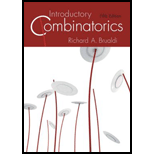Solutions for Introductory Combinatorics
Problem 3E:
Imagine a prison consisting of 64 cells arranged like the squares of an 8-by-8 chessboard. There are...Problem 10E:
Verify that there is no magic square of order 2.
Problem 13E:
Construct a magic square of order 6.
Problem 16E:
Show that the result of replacing every integer a in a magic square of order n with n2 + 1 – a is a...Problem 17E:
Let n be a positive integer divisible by 4, say n = 4m. Consider the following construction of an...Problem 18E:
Show that there is no magic cube of order 2.
Problem 19E:
Show that there is no magic cube of order 4.
Problem 23E:
Construct Latin squares of orders 5 and 6.
Browse All Chapters of This Textbook
Chapter 1 - What Is Combinatorics?Chapter 2 - Permutations And CombinationsChapter 3 - The Pigeonhole PrincipleChapter 4 - Generating Permutations And CombinationsChapter 5 - The Binomial CoefficientsChapter 6 - The Inclusion-exclusion Principle And ApplicationsChapter 7 - Recurrence Relations And Generating FunctionsChapter 8 - Special Counting SequencesChapter 9 - Systems Of Distinct RepresentativesChapter 10 - Combinatorial Designs
Sample Solutions for this Textbook
We offer sample solutions for Introductory Combinatorics homework problems. See examples below:
To show this, we have to add 3 cases here. Case 1: Assume that one of m and n is even and the second...Procedure used: Multiplication principle: When a task has p outcomes and, no matter what the outcome...Given: The cumulative number of games played on the first n days is denoted by an, where n=1,2,…,77....Algorithm used: Begin with 1←,2←,⋯,n←. While there exists a mobile integer, do the following: (1)...Formula used: The pascal’s triangle formula is: (nk)=n!k!(n−k)!=n(n−1)⋅⋅⋅(n−k+1)k(k−1)⋅⋅⋅1...Suppose the set S={1,2,...,104}. Let A, B, C be the set of integers S that are divisible by 4, 5, 6...Using the mathematical induction and the Fibonacci recurrence. The sequence of numbers...Chapter 8, Problem 1EDefinition used: Let Y be a finite set and A=(A1,A2,…,An) be a family of n subsets of Y. A family...
Definition used: “Let n be a positive integer with n≥2, then Zn={0,1,…,n−1}.” “For any two integers...Definition used: “Two general graphs G=(V,E) and G=(V′,E′) are called isomorphic, provided that...Definition used: Chromatic number: Let G=(V,E) be a graph. A vertex coloring of G is an assignment...The given permutations are, f=(123456642153) and g=(123456356241). Here, (f∘g)(1)=2, (f∘g)(2)=5,...
More Editions of This Book
Corresponding editions of this textbook are also available below:
Related Math Textbooks with Solutions
Still sussing out bartleby
Check out a sample textbook solution.
